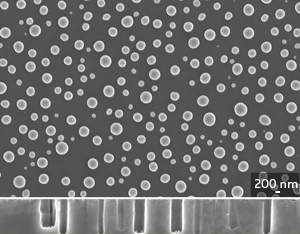Solar cells: Powered by nanoholes

A straightforward procedure that transforms silver nanospheres (top) into silicon nanoholes (bottom) can overcome the shortcomings of nanowire-based solar cells Reproduced, with permission, from Ref.1 © 2014 American Institute of Physics
Increasing the cost-effectiveness of photovoltaic devices is critical to making these renewable energy sources competitive with traditional fossil fuels. One possibility is to use hybrid solar cells that combine silicon nanowires with low-cost, photoresponsive polymers.
The high surface area and confined nature of nanowires allows them to trap significant amounts of light for solar cell operations. Unfortunately, these thin, needle-like structures are very fragile and tend to stick together when the wires become too long.
Now, findings by Xincai Wang from the A*STAR Singapore Institute of Manufacturing Technology and co-workers from Nanyang Technological University could turn the tables on silicon nanowires by improving the manufacturing of silicon ‘nanoholes’ — narrow cavities carved into silicon wafers that have enhanced mechanical and light-harvesting capabilities(1).
Nanoholes are particularly effective at capturing light because photons can ricochet many times inside these openings until absorption occurs. Yet a practical understanding of how to fabricate these tiny structures is still lacking. One significant problem, notes Wang, is control of the initial stages of nanohole formation — a crucial period that can often induce defects into the solar cell.
Instead of traditional time-consuming lithography, the researchers identified a rapid, ‘maskless’ approach to producing nanoholes using silver nanoparticles. First, they deposited a nanometre-thin layer of silver onto a silicon wafer which they toughened by annealing it using a rapid-burst ultraviolet laser. Careful optimization of this procedure yielded regular arrays of silver nanospheres on top of the silicon surface, with sphere size and distribution controlled by the laser annealing conditions.
Next, the nanosphere–silicon complex was immersed into a solution of hydrogen peroxide and hydrofluoric acid — a mixture that eats away at silicon atoms directly underneath the catalytic silver nanospheres. Subsequent removal of the silver particles with acid produced the final, nanohole-infused silicon surface (see image).
The team analyzed the solar cell activity of their nanohole interfaces by coating them with a semiconducting polymer and metal electrodes. Their experiments revealed a remarkable dependence on nanohole depth: cavities deeper than one micrometer showed sharp drops in power conversion efficiency from a maximum of 8.3 per cent due to light scattering off of rougher surfaces and higher series resistance effects.
“Our simple process for making hybrid silicon nanohole devices can successfully reduce the fabrication costs which impede the solar cell industry,” says Wang. “In addition, this approach can be easily transferred to silicon thin films to develop thin-film silicon–polymer hybrid solar cells with even higher efficiency.”
Reference
1. Hong, L., Wang, X., Zheng, H., He, L., Wang, H., Yu, H. & Rusli, E. High efficiency silicon nanohole/organic heterojunction hybrid solar cell. Applied Physics Letters 104, 053104 (2014).
Associated links
Media Contact
More Information:
http://www.researchsea.comAll latest news from the category: Power and Electrical Engineering
This topic covers issues related to energy generation, conversion, transportation and consumption and how the industry is addressing the challenge of energy efficiency in general.
innovations-report provides in-depth and informative reports and articles on subjects ranging from wind energy, fuel cell technology, solar energy, geothermal energy, petroleum, gas, nuclear engineering, alternative energy and energy efficiency to fusion, hydrogen and superconductor technologies.
Newest articles

Bringing bio-inspired robots to life
Nebraska researcher Eric Markvicka gets NSF CAREER Award to pursue manufacture of novel materials for soft robotics and stretchable electronics. Engineers are increasingly eager to develop robots that mimic the…

Bella moths use poison to attract mates
Scientists are closer to finding out how. Pyrrolizidine alkaloids are as bitter and toxic as they are hard to pronounce. They’re produced by several different types of plants and are…

AI tool creates ‘synthetic’ images of cells
…for enhanced microscopy analysis. Observing individual cells through microscopes can reveal a range of important cell biological phenomena that frequently play a role in human diseases, but the process of…





















